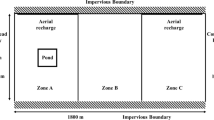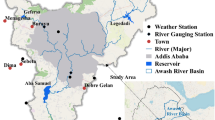Abstract
The sulfate pollution in an agriculturally used watershed has been investigated with respect to the transport in the saturated zone and the development of sulfate in the unsaturated zone. Besides of other sources such as acid wet and dry deposition or sulfate input by agricultural activities, most of the sulfate originates from oxidation of pyrite by either NO3 or O2. High sulfate concentrations coincided with high nitrate leaching caused by plowing of former grassland or by vegetable crop residues and with former wet lands that have become dry. By using soil water concentration data and maps showing the extension of former wetlands and grassland as well as agricultural land use, it was possible to delineate regions of high sulfate input. The transport of sulfate in the aquifer was analyzed with a modified version of the USGS MOC model, which takes into account the nonlinearity of the underlying equation describing unconfined groundwater flow. The calibration of the transport model showed good agreement between the estimated and modeled sulfate input rates. A prediction of future sulfate concentrations in the aquifer was feasible by using “worst-case” parameters.
Similar content being viewed by others
References Cited
Anderson, M. P., 1979, Using models to simulate the movement of contaminants through groundwater flow systems: CRC Crit. Rev. Environ. Control, v. 9, p. 97–156.
Bear, J., 1972, Dynamics of fluids in porous media: New York, American Elsevier, 764 p.
Beyer, W., and K. H. Schweiger, 1969, Zur Bestimmung des entwässerbaren Porenanteils der Grundwasserleiter: WWT, v. 19, p. 57–60.
Duynisfeld, W. H. M., and O. Strebel, 1990, Einfluss von Standorteigenschaften und Bodennutzung auf die Nitratauswaschung aus dem Wurzelraum, in W. Walther, ed., Grundwasserbeschaffenheit in Niedersachsen-Diffuser Nitrateintrag, Fallstudien, Inst. f. Siedlungswasserwirtschaft TU Braunschweig, v. 48, p. 205–223.
Duynisfeld, W. H. M., O. Strebel, J. Böttcher, and W. Kinzelbach, 1989, Longterm prognosis of the groundwater quality as influenced by landuse and landuse changes in the Fuhrberger Feld using numerical solute transport models,in H. Kobus, and W. Kinzelbach, eds., Contaminant Transport in Groundwater: Rotterdam, Balkema, p. 89–96.
Kersebaum, K. C., and J. Richter, 1990, Modelling nitrogen dynamics in a plant-soil system with a simple model for advisory purposes: Fertilizer Research, v. 27, p. 273–281.
Kinzelbach, W., 1987, Numerische Methoden zur Modellierung des Transports von Schadstoffen im Grundwasser: München, R. Oldenburg Verlag, 317 p.
Kölle, W., O. Strebel, and J. Böttcher, 1985, Formation of sulfate by microbial denitrification in a reducing aquifer: Water Supply, v. 3, p. 35–40.
Konikow, L. F., and J. D. Bredehoeft, 1978, Computer model of two-dimensional solute transport and dispersion in ground water: Techniques of Water-Resources Investigations of the USGS, Book 7, Chapter C2, Washington, D.C., 90 p.
Prickett, T. A., and G. Lonnquist, 1971, Selected digital computer techniques for groundwater resource evaluation: Illinois State Water Survey, Bulletin 55, Urbana, IL, 62 p.
Renger, M., and O. Strebel, 1980, Jährliche Grundwasserneubildung in Abhängigkeit von Bodennutzung und Bodeneigenschaften: Wasser Boden, v. 8, p. 362–366.
Richter, G. M., A. Hoffmann, R. Nieder, and J. Richter, 1989a, Nitrogen mineralisation in loamy arable soils after increasing the ploughing depth and ploughing grasslands: Soil Use Manage. v. 5, p. 169–173.
Richter, J., R. Anlauf, and G. M. Richter, 1989b, Nitrataustrag von Böden ins Grundwasser in verschieden belasteten Trinkwasser-Einzugsgebieten Niedersachsens: Annual report Project No. 0339121 A, Federal Ministry of Science and Technology (BMFT), Bonn.
Richter, J., R. Anlauf, F. Aschenbrenner, and G. M. Richter, 1990, Nitrataustrag von Böden ins Grundwasser in verschieden belasteten Trinkwasser-Einzugsgebieten Niedersachsens: Annual report Project No. 0339121 B, Federal Ministry of Science and Technology (BMFT), Bonn.
Scheffer/Schachtschabel, 1989, Lehrbuch der Bodenkunde. Soil Science Textbook, 12th ed.: Stuttgart, Verlag Ferdinand Enke, 274 f.
Scheidegger, A. E., 1961, General theory of dispersion in porous media: J. Geophys. Res. v. 66, p. 3273–3278.
Strebel, O., and J. Böttcher, 1985, Einfluss von Bodennutzung und Bodennutzungsaenderungen auf die Stoffbilanz eines reduzierenden Aquifers im Einzugsgebiet eines Förderbrunnens: Wasser Boden v. 3, p. 111–114.
Strebel, O., and J. Böttcher, 1989, Solute input into groundwater from sandy soils under arable land: Agric. Water Manage. v. 15, p. 265–271.
Todd, D. K., 1980, Groundwater hydrology: New York, John Wiley & Sons Inc., 535 p.
Vemuri, V., and W. J. Karplus, 1981, Digital computer treatment of partial differential equations: Englewood Cliffs, NJ, Prentice-Hall, 449 p.
Author information
Authors and Affiliations
Rights and permissions
About this article
Cite this article
Aschenbrenner, F., Richter, G.M. & Richter, J. Modeling groundwater quality in an agriculturally used water catchment. Environ. Geol. Water Sci 20, 43–55 (1992). https://doi.org/10.1007/BF01736109
Issue Date:
DOI: https://doi.org/10.1007/BF01736109




